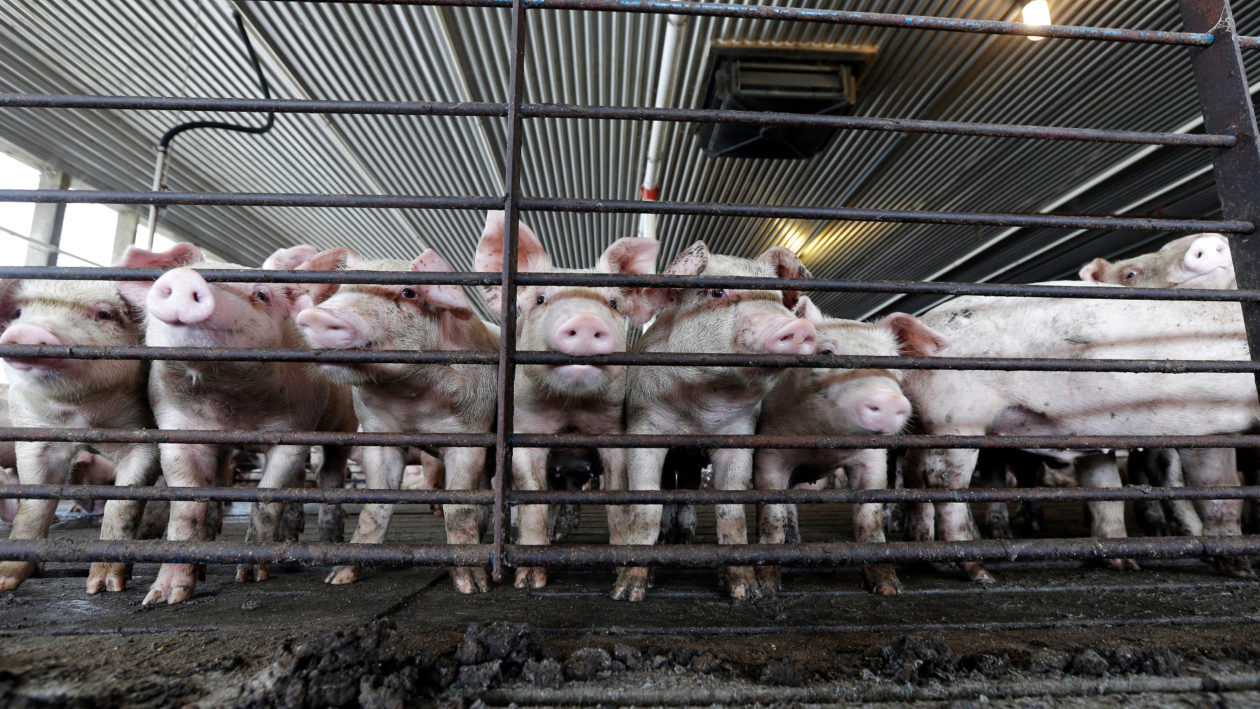
Young hogs at Everette Murphrey Farm in Farmville, North Carolina. The state's 9 million hogs produce 10 billion gallons of waste a year. AP PHOTO/GERRY BROOME
BY CRAIG VOLLAND, Kansas Chapter Agriculture Committee Chair
The Sierra Club and other environmental groups oppose more efforts by CAFOs to produce biogas, what we call "factory farm" gas. Nationwide, these projects create an incentive to produce even more manure at hog factories and industrial scale dairies that will be stored as wastewater in large impoundments called lagoons. This costly digester and gas collection infrastructure is economically feasible only through various federal subsidies and private or state-sponsored carbon offset credits.
Using waste from 330,000 hogs in their massive Ladder Creek East and West CAFOs, Seaboard is jumping on the so-called "renewable natural gas" bandwagon promoted by the USDA, Big Ag and the natural gas industry. Most of Seaboard's waste lagoons will be covered to capture methane, a greenhouse gas, for use in the existing natural gas pipeline network.
This factory farm gas must be "cleaned" in a downstream separation facility. So we asked KDHE to investigate how those emissions would be assessed and handled. KDHE responded that they were only concerned with the water quality permit and, "The facility is responsible to obtain any additional permits from other federal, state or local agencies that may be required." Umm . . , KDHE, you are the applicable state agency that issues air quality permits in Kansas.
Projects like this lock in both the existing natural gas infrastructure and many CAFO environmental hazards, such as air pollution from the barns, wastewater runoff and groundwater contamination. Some of the captured methane will be lost through the existing leak-prone natural gas distribution system. Some research suggests that the manure digestion process changes the chemistry of the residuals so that more nitrous oxide may be emitted when the residuals are applied to fields. Nitrous oxide is a greenhouse gas 10-15 times more potent than methane with a much longer lifespan.
Our analysis of the permit application found that Seaboard has all but abandoned plans to apply their wastewater on crop fields as fertilizer. In fact, the lagoon contents are already too saline for that use, but what they're planning could be worse. Instead, they are converting some lagoons to evaporation ponds and building new ones. After 20 more years of evaporating wastewater from 330,000 hogs, what remains will likely be equivalent to a massive amount of hazardous waste. KDHE did not respond specifically to these concerns, merely promising that Seaboard will provide a new closure plan after the permit is issued.
Finally, we noted that the new permit allowed Seaboard to punch holes in any plastic lagoon liner that showed evidence of trapped air (actually off-gases from wastewater leakage). We asked that KDHE require Seaboard to notify them before taking any such action. We want a KDHE inspector to confirm that such action is necessary and witness what measures are being taken to prevent damage to the underlying soil liner.
The backstory: in order to satisfy concerns about their expanding network of large hog confinements, Seaboard Farms announced in 1998 that they would line all their new waste impoundments with 40-mil high density plastic to protect groundwater. On Nov. 8, 1999, in testimony to the legislature, then KDHE Secretary Clyde Graeber confirmed that Seaboard had committed to use plastic liners on all lagoons on any new facility they build in Kansas. In response to our current concern, KDHE merely noted that they no longer hold the company to that commitment, and re-issued their permit.
For more information - Swine Production and Environmental Stewardship (EPA)
Rhetoric vs. Reality: The Myth of "Renewable Natural Gas" for Building Decarbonization
Turning Hog Waste Into Biogas: Green Solution or Greenwashing?
>